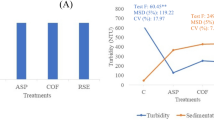Abstract
A study was conducted to standardize the technology for the removal of amino acids (one of the browning reaction substrates) from sweet orange cv. Malta Common juice to reduce colour and quality deterioration in single strength juice and during subsequent concentration. Juice of sweet orange (Citrus sinensis) cv. Malta Common fruits was extracted by screw type juice extractor, preserved in 500 ppm SO2 and clarified by using “Pectinase CCM” enzyme (0.2% for 2 h at 50 ± 2 °C). For removal of amino acids juice was passed under gravity through a glass column packed with an acidic cation exchange resin (CER), Dowex-50 W and quantity to be treated in one lot was standardized. The CER treated and untreated juices were concentrated to 15 and 30°Brix in a rotary vacuum evaporator. Results indicate that 121 ml of orange juice when passed through a glass column (5 cm internal diameter) packed with cation exchange resin (Dowex-50 W) upto a height of 8 cm, could remove about 98.4% of the amino acids with minimum losses in other juice constituents. With cation exchange resin treatment, the non-enzymatic browning and colour deterioration of orange juice semi-concentrates was reduced to about 3 folds in comparison to untreated counterparts. The retention of vitamin C and sugars was also better in semi-concentrates prepared from cation exchange resin treated juice. Thus, cation exchange resin treatment of orange juice prior to concentration and storage is highly beneficial in reduction of non-enzymatic browning, colour deterioration and retention of nutritional, sensory quality of product during preparation and storage.


Similar content being viewed by others
References
AOAC (1995) Official methods of analysis of AOAC international, 16th edn. Association of Official Analytical Chemists, Arlington, p 66
Chadha KL (2006) Handbook of horticulture. Indian Council of Agricultural Research, New Delhi, p 329
Chopra S, Kudos SKA, Oberoi HS, Baboo B, Ahmad KUM, Kaur J (2004) Performance evaluation of evaporative cooled room for storage of Kinnow mandarin. J Food Sci Tech 41(5):573–577
Cochran WG, Cox GW (1967) Experimental designs. John Wiley and Sons, Inc., New York, p 613
Cohen E, Lurie S, Shapiro B, Yehoshub SB, Shalon Y, Rosenberger I (1990) Prolonged storage of lemons using individually seal packaging. J Amer Soc Hortl Sci 115(2):251–255
Cornwell CJ, Wrolstad RE (1981) Causes of browning in pear juice concentrate during storage. J Food Sci 46:515–518
Ghosh SP, Mitra SK, Singh S (2002) Citrus. In: Bose TK, Mitra SK, Sanyal D (eds) Fruits: tropical and subtropical, vol 1. Naya Udyog, Calcutta, pp 109–225
Giese JH (1992) Hitting the spot: beverages and beverage technology. Food Tech 46(7):70–80
Handwerk RL, Coleman RL (1988) Approaches to the citrus browning problem – a review. J Agri Food Chem 36:231–236
Kacem B, Matthews RF, Crandall PG, Cornell JA (1987) Non-enzymatic browning in aseptically packaged orange juice and orange drinks – effect of amino acids deaeration and anaerobic storage. J Food Sci 52:1665–1667
NHB (2009) Statewise area and production of sweet orange in India. www.hortibizindia.org website visited on 8th December 2009
Premi BR, Lal BB, Joshi VK (1995) Efficacy of various techniques for removing bitter principles in Kinnow juice. J Food Sci Tech 32(4):332–335
Pruthi JS, Manan JK, Teotia MS, Sethy R, Eipenson WE, Saroja S, Chikkoppaji KC (1984) Studies on the utilization of kinnow and malta oranges. J Food Sci Tech 21:123–125
Rai P, De S (2009) Clarification of pectin containing juice using ultrafiltration. Curr Sci 96(10):1361–1371
Ranganna S (1997) Handbook of analysis and quality control for fruit and vegetable products, 2nd edn. Tata McGraw-Hill Pub Co Ltd, New Delhi, p1112
Sharma SK (2010) Postharvest management and processing of fruits and vegetables. New India Pub Agency, New Delhi, 390p
Sharma SK, Nautiyal MC (2007) Postharvest management of malta - low cost technology for storage and value addition. Technical Bulletin No.FHA/17/Hort./07. Univ of Hort and Forestry, Ranichauri, Tehri Garhwal, Uttarakhand, India, 22p
Sharma SK, Nautiyal MC (2009) Postharvest technology of horticultural crops - practical manual seires – 2. New India Pub Agency, New Delhi, 229p
Sharma PC, Sharma SK, Kaushal BBL (2001) Preparation and evaluation of some value added products from lemon (Citrus pseudolimon Tan.) fruits. Indian J Agri Sci 71:691–694
Sharma SK, Kaushal BBL, Sharma PC (2004) Effect of temperature and removal of amino acids on non-enzymatic browning of lemon juice concentrates during storage. J Sci Ind Res 63:444–451
Sharma SK, Kaushal BBL, Sharma PC (2006) Reduction of non-enzymatic browning of lemon juice concentrates by removal of reaction substrates. J Food Sci Tech 43(1):83–88
Sharma SK, Kaushal BBL, Sharma PC (2009) Effect of cation exchange resin treatment and addition of anti-caking agent on non-enzymatic browning of lemon juice powder during storage. J Sci Ind Res 68:611–616
Sharma SK, Kaushal BBL, Sharma PC (2011) Effect of cation exchange resin treatment and addition of sugar as anti-caking agent on retention of nutritional and sensory quality of lemon juice powder during storage. J Food Sci Tech 48(3):296–304
Singh S, Gupta R (2003) Apple juice clarification using fungal pectinolytic enzyme and gelatin. Indian J Biotechnol 3:573–576
Soule J, Grierson W (1986) Maturity and grade standards. In: Wardowski WF, Nagy S, Grierson W (eds) Fresh citrus fruits. Van Nostrand Reinhold Co, Melbourne, pp 23–46
Tanushree CCS, Singh CP (2009) Studies on standardization and shelf stability of malta (Citrus sinensis) orange beverages. Indian Food Packer 65(5):46–53
Ting SV (1956) Rapid colorimetric methods for simultaneous determination of total reducing sugars and fructose in citrus juices. J Agr Food Chem 4:263–266
Ting SV, Deszyck EJ (1960) Total amino acid content of chilled orange juice and frozen concentrate. Proc Fla State Hortl Soc 73:252–257
Author information
Authors and Affiliations
Corresponding author
Rights and permissions
About this article
Cite this article
Sharma, S.K., Juyal, S., Rao, V.K. et al. Reduction of non-enzymatic browning of orange juice and semi-concentrates by removal of reaction substrate. J Food Sci Technol 51, 1302–1309 (2014). https://doi.org/10.1007/s13197-012-0632-0
Revised:
Accepted:
Published:
Issue Date:
DOI: https://doi.org/10.1007/s13197-012-0632-0




